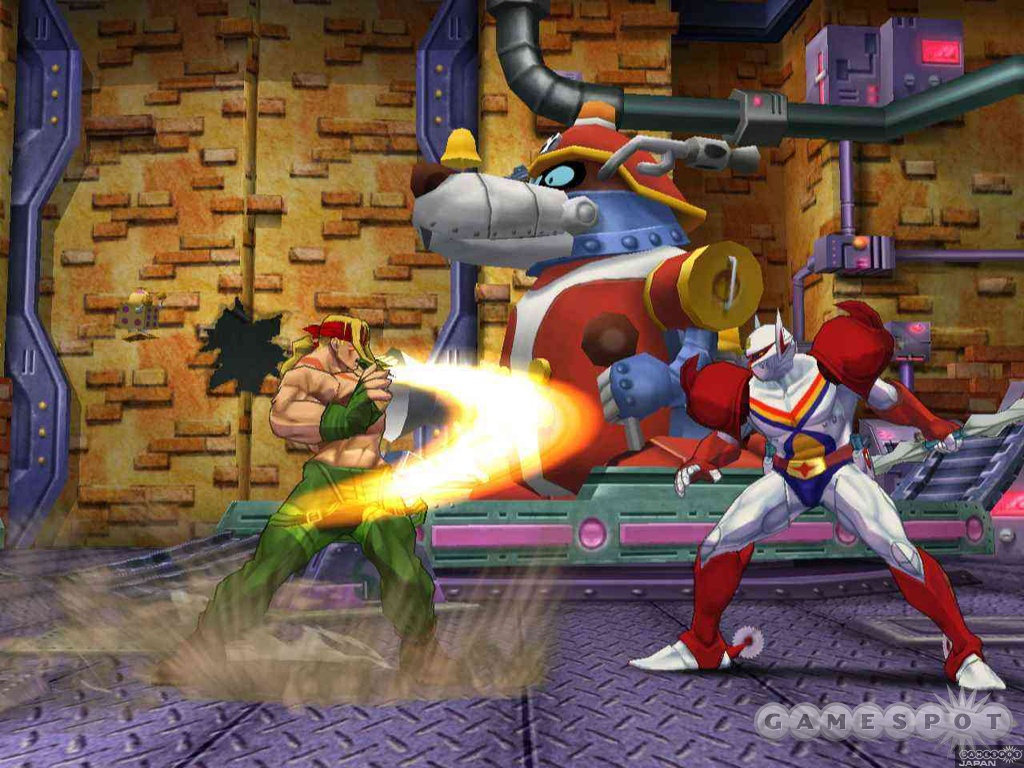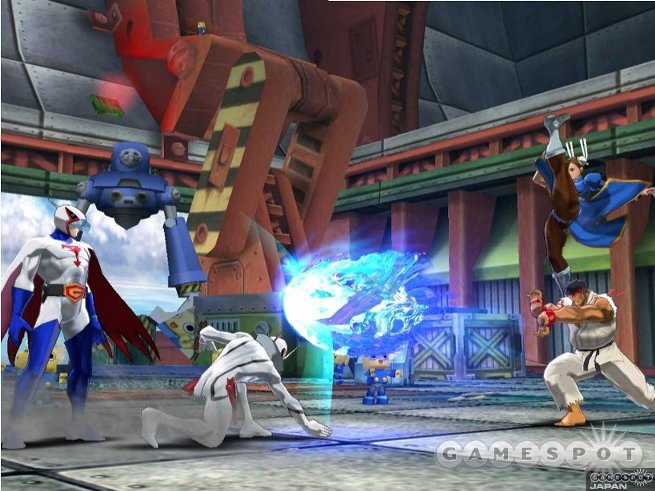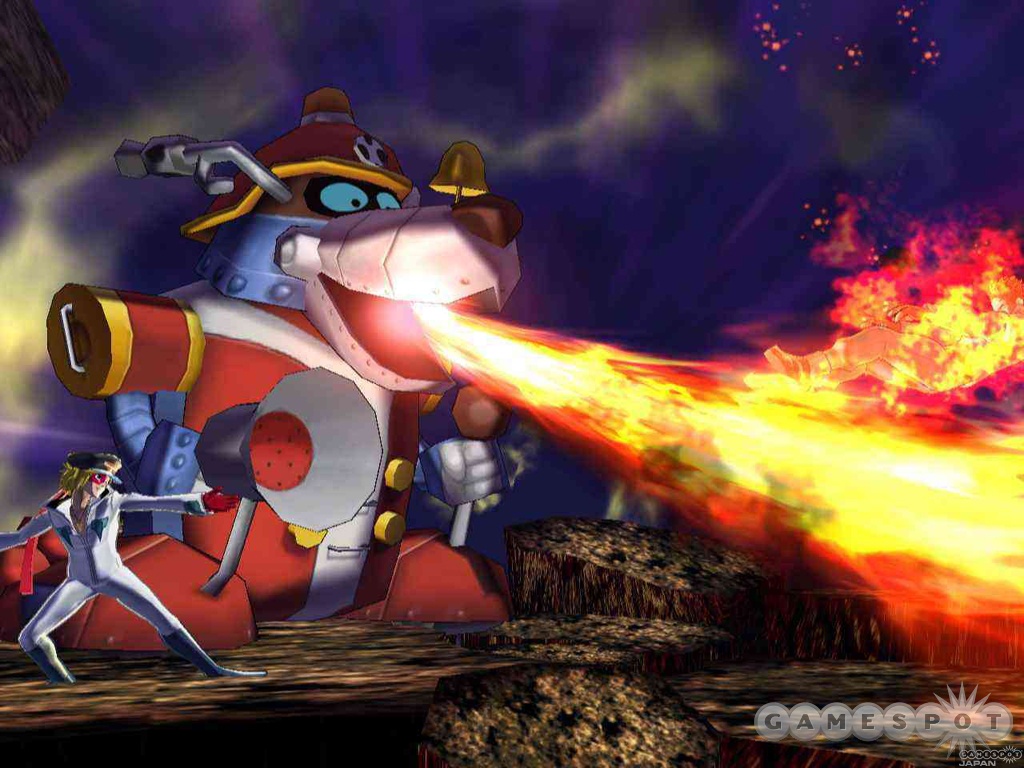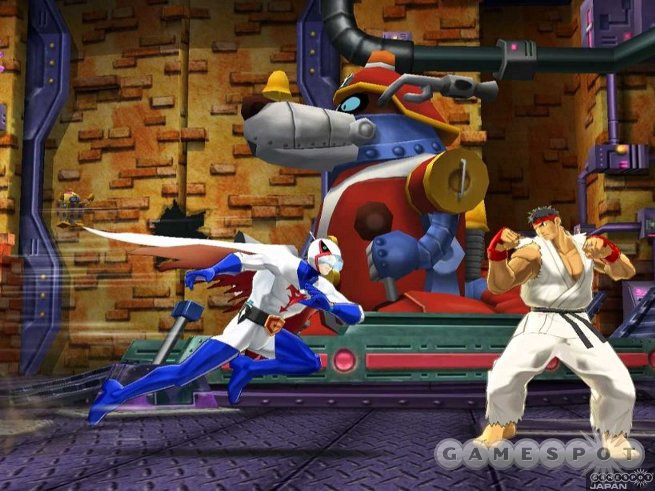Tatsunoko vs. Capcom Beta Test Hands-On
It's Ryu and Chun-Li versus a whole bunch of 1970s anime characters in Capcom's latest fighting-game
If you're a fan of Capcom's crossover "vs." fighting-game series and you've been waiting a long time for a new game, it's time to get ready. After nearly eight years of series hiatus, Capcom has announced Tatsunoko vs. Capcom: Cross Generation of Heroes, which will pit Capcom heroes against various characters from Tatsunoko Productions' anime series. Its development is apparently moving along quickly, and though it's been only two months since the game's unveiling, it's already out on beta testing in Japan. Today, we had a chance to see how the game is shaping up at one of the test locations in Akihabara.

Tatsunoko vs. Capcom plays in the so-called 2.5D format; it uses 3D graphics and plays with 2D mechanics. The characters are drawn in a cel-shading style that makes them look a bit like drawings, which seems appropriate, considering that the game's crossover partner, Tatsunoko, is an animation studio. The backgrounds are rendered in semirealistic 3D, which doesn't match up with the character renderings and consequently makes them stand out.
Although 2D to 3D transitions are often controversial for fighting games, it seems to have done a lot of good for Tatsunoko vs. Capcom, and the characters move very smoothly. Morrigan moves around even smoother than in her sprite animations from the Dark Stalker series, and for the first time, Ryu's shin shoryuken doesn't pixelate when the game is zoomed in on him. There's some extremely nice camerawork when some of the fighters execute their hyper combos, and in all cases, the view zooms up on the characters for a short moment.
At this beta test, all of the Tatsunoko vs. Capcom machines were installed in Vewlix cabinets, which are the same models that will be used in Street Fighter IV when it officially ships. We weren't expecting Tatsunoko vs. Capcom's graphics to be as well animated or well textured as Street Fighter IV, given that the "vs." series has always been about quantity over quality, and so far, it seems that our assumptions were right. That's not to say that the game moves choppily; rather, by comparison, Street Fighter IV is just too well animated. Aside from animation, Tatsunoko vs. Capcom didn't look as high-definition as Street Fighter IV, even though it was running on the same cabinet. Capcom hasn't announced anything about home ports, but it seems quite plausible that the game is being developed with that in mind.
Tatsunoko vs. Capcom plays in a two-on-two-tag battle format, in which the player who beats both of the opponent's characters wins. You have two life bars on the top of the screen, one each for your two characters, and a power meter at the bottom of the screen. If you've played Marvel vs. Capcom 2, you shouldn't have too many problems getting used to Tatsunoko vs. Capcom because it inherits most of the same gameplay. However, there are some differences in the controls, with the biggest change being the button layout.
Tatsunoko vs. Capcom is played with the joystick and four buttons, three of which are used for attacks (weak attack, strong attack, and fierce attack), and one of them for calling out the tag partner. Having only three attack buttons isn't much of a problem when you're using the new characters, but it can be a bit mind-boggling for the first time when you're using an old character. For example, Chun-Li has kicks for her crouching strong and fierce attacks, but for some reason, she has a punch for her crouching weak attack. On the other hand, all three of Ryu's crouching attacks are kicks.
Air combos have long been one of the main appeals of the "vs." series, and the tradition continues with Tatsunoko vs. Capcom. In fact, doing air combos in the game is a lot easier than in previous installments because the motion for thrusting an enemy into the air (called the aerial rave launcher) has been unified to "forward-down + fierce" for all of the characters. This proved to be useful during the beta test, given that players could effectively use Tatsunoko characters without having to search for their launchers.
Similarly to previous installments, Tatsunoko vs. Capcom features the advancing-guard move, which pushes the opponent away. This useful move can be performed by pressing all three attack buttons together while guarding.
The partner button can be used in a variety of ways. Pressed alone, the partner comes out to aid the fighting character (known as the variable assist). Similarly to Marvel vs. Capcom 2, the partner can be called out while the fighting character is in the middle of a combo. Tagging is done a bit differently from previous games: You need to hold back on the joystick when pressing the partner button. The partner in the background can regain the red portion of his or her depleted life bar. Given that it's still early in the beta testing, we saw a lot of cases in which players simply forgot to hold back to tag away, ending up calling their partners for assistance and getting punished with attacks.
The partner button can also be used for variable counters in which you switch partners while in the middle of guarding (at the cost of one power bar), and for variable combinations in which you can use three power bars to make both of your characters execute their hyper-combo moves, as well as for a new move called a variable air raid, in which you can switch partners while in midair (which costs one power bar).

Tatsunoko vs. Capcom has two new systems called "baroque" and "mega crush," both of which are supposed to be effective in making a comeback. Unfortunately, Capcom hasn't elaborated with any details, and nobody seemed to be using them effectively at day one of beta testing. According to Capcom, baroque is a move with which you can power up and do a devastating combo in exchange for sacrificing the red portion of the life meter that's recoverable by tagging. It can be executed by pressing the partner button and an attack button simultaneously while in the middle of an attack.
From what we've played, the baroque move can be executed only while in the middle of an attack, and it cancels whatever attack you were doing, letting you launch another new combo at your opponent. The character shines for a while when the baroque is executed. We're guessing that attacks in the meantime do more damage than usual.
Mega crush supposedly lets you perform a powerful attack in exchange for two power bars and some of your life. The move is executed by pressing all four buttons together. However, the move seemed to have an extremely short range, and it wasn't seen being used by players.
The version of Tatsunoko vs. Capcom that we saw featured 12 characters, six from Capcom and six from Tatsunoko (one appears as a boss rather than a playable character). The character-select screen wasn't the typical type that had character slots; instead, it featured an elliptical ring of characters on the bottom of the screen, so there were no hints as to the total number of fighters in the game.

In addition to their usual set of moves, all characters have two hyper combo attacks and one lv3 hyper combo that requires three power bars. Given that you can stock up more than three power bars, some of the characters can do interesting combos. We've also confirmed super cancels, such as Ryu executing a shinkuu hadouken after a regular hadouken.
Taking a quick look at each of the characters beginning with Capcom's side, the famous street fighter Ryu is once again back in action, and he seems to be based on his Street Fighter III: Third Strike version. His shinkuu hadouken shoots like a wide laser similar to previous "vs." games, and as of now is a relatively unpunishable chipping attack favored by many of the players. His lv3 hyper combo is a shin shoryuken, which is animated quite dramatically as compared to previous games.
Chun-Li seems to be based on her old Street Fighter II style rather than Third Strike, and she has her antiair tenshoukyaku move as well as her spinning bird kick and aerial hyakuretsu kyaku kicks. Her Lv3 hyper combo is shichesei senkuukyaku, the aerial kick from the original Marvel vs. Capcom (for some reason, it was gone in Marvel vs. Capcom 2).
Alex from Street Fighter III looks as strong as ever, and now we get to see him rip his shirt in 3D during his prefight demo. At the current stage of development, Alex seems to be benefiting a lot from the transition out of his original game. He now has all of his super-arts moves from Third Strike as hyper combos. He was a popular character among the beta testers, especially considering that his boomerang raid hyper combo could be connected to his hyper bomb (lv3 hyper combo), doing massive damage.
Morrigan from Dark Stalkers seems to have all of her moves intact, including her vector-drain throw (which initiates some very nice camerawork), as well as her valkyrie-turn hyper combo. Her motions are based on her old sprites, but this game should still be refreshing for fans of Morrigan who have gotten tired of her old moves.
Batsu from Rival Schools finally makes a comeback in a fighting game, and he has his trademark moves, including the kiai-dan and guts uppercut. His lv3 is a team-up special performed in tandem with his teamed-up partner.
Souki from Onimusha: Dawn of Dreams is the only non-fighting-game character in Capcom's roster at the current time. He wields a huge sword and seems to play as a midrange power fighter, somewhat reminiscent of Haohmaru in SNK vs. Capcom, but with totally different special moves. He has a counter move called hajiki issen based on the action style from the Onimusha series, and when it succeeds, he can follow up with a rensa issen for additional damage. His lv3 hyper combo makes him turn into an oni (demon) for a limited time while his power bar slowly drains down to zero.
The Tatsunoko characters are all from anime shows back in the '70s, so they're mostly unknown to young Japanese gamers, not to mention American gamers. Nevertheless, they've got a good-sized following in Japan. Some of the shows have had a new series in recent years, such as Yatterman, and Neo-Human Casshan has been made into a movie.
Casshern from Neo-Human Casshern is based on the 1973 anime rather than the 2004 motion picture. Most of his moves seemed to be close-range maneuvers, and staying truthful to the anime, he has a slice attack with his hand. His robotic dog Friender is also in the game, and it can be called to attack the opponent a bit like Samurai Shodown's Galford (except Galford's dog doesn't blow fire out of its mouth).
Tekkaman from Tekkaman: The Space Knight (1975) looks quite buff compared to average-sized fighters like Ryu, and he wields a double-headed spear that gives him quite a long range. Aside from having an antiair move in which he twirls around the spear while jumping, he can also throw the spear forward as a multiple-hitting projectile. He also has a long chain that he can shoot from one of his arms. During his supers, he blasts a huge energy wave at the opponent.
Ken from Science Ninja Team Gatchaman (1972, better known in the States as Battle of the Planets) wears a white, birdlike costume complete with a beaked helmet. He seemed to play as a speedy sort of character with a teleport attack.

Polymar from Hurricane Polymar (1974) plays quite differently from any other character in the game. Given that his anime series was strongly influenced by the Bruce Lee films of the time, he fights with a similar kung-fu pose, and he's a close-range fighter who relies on quick attacks and combinations. When you play with Polymar, three Polymar symbols appear on the top of the power bar. Somewhat similarly to Jam Kuradoberi's system in the Guilty Gear X series, Polymar can do a pose that lets him stock up Polymar symbols. Doing so will let him attack with extra moves when he's doing a special. He also needs three Polymar symbols to do his lv3 hyper combo.
Yatterman No.1 from Yatterman (1977) doesn't wear a power-up costume like the other Tatsunoko superheroes (he wears a jumpsuit), but he's got a Kendama (Bilboquet), which is a hammerlike object attached with a string and ball, giving him an extremely long range like Street Fighter II's Dhalsim. In his hyper combo, he calls out his large Yatterwan dog mech, which can ram into the opponent or shoot fire out of its mouth.
Gold Lightan from Golden Warrior Gold Lightan (1981) appears as a boss in the fourth and last stage on the single-player mode of the beta test. He's a square, gold metallic lighter that's about four times as tall as any of the other fighters. Given his size, he can simply step on your character. He can also do a body press, and he needs to crouch at times when he punches. What's more, he's got hyper armor, which means that he doesn't get knocked back at all when he's attacked.
So far, Tatsunoko vs. Capcom played pretty solidly at today's testing, and we're looking forward to see how it progresses in future beta tests. The game is slated for Japanese arcades thi
Got a news tip or want to contact us directly? Email news@gamespot.com
Join the conversation